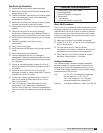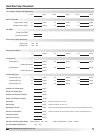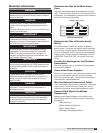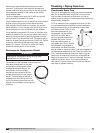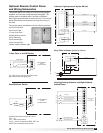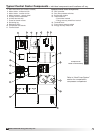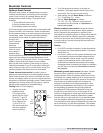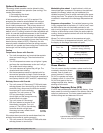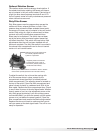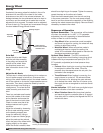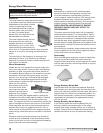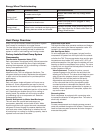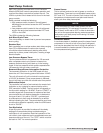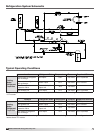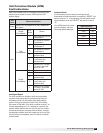
20
Model ERCH-HP Energy Recovery Unit
Optional Economizer
The energy wheel operation can be altered to take
advantage of economizer operation (free cooling). Two
modes are available:
1. De-energizing the wheel.
2. Modulating the wheel.
A field-supplied call for cool (Y1) is required. De-
energizing the wheel is accomplished with a signal
from a temperature or enthalpy sensor mounted in
the air intake compartment. This primary sensor will
de-energize the energy wheel when the outdoor air
temperature (factory default is 65ºF) or enthalpy (factory
default is the ‘D’ setting) is below the field adjustable set
point. An override temperature sensor is also furnished
in the outdoor air intake compartment to deactivate
economizer mode. The override (with field adjustable set
point) is set at some temperature lower than the primary
sensor (factory default is 50ºF). Effectively, the two
sensors create a deadband where the energy recovery
wheel will not operate and free cooling from outside can
be brought into the building unconditioned.
Testing
Temperature Sensor with Override
• Turn both temperature and override thermostats
down as low as they go. The wheel should be
rotating.
• Turn the temperature sensor up as high as it goes,
and keep the override sensor as low as it will go.
The wheel should stop rotating.
• Turn both sensors as high as they will go. The
wheel should start rotating.
• Set the temperature sensor at desired point for
economizer operation to begin. Set the override
sensor at desired point for economizer operation to
end (factory default is 65ºF and 50ºF, respectively).
Enthalpy Sensor with Override
• Turn unit power off. Disconnect C7400 solid state
enthalpy sensor from terminal So on the enthalpy
controller. Also, disconnect the 620 ohm resistor
from terminal Sr on the enthalpy
controller. Turn unit power on. The
LED on the enthalpy controller
should light and the energy recovery
wheel should not rotate.
• Turn unit power off. Reconnect
620 ohm resistor to terminal Sr on
the enthalpy controller. Turn unit
power on. The LED on the enthalpy
controller should not light and
the energy recovery wheel should
energize and rotate.
If the steps above provide the results described, the
enthalpy economizer is working properly.
• Turn unit power off. Reconnect C7400 solid state
enthalpy sensor to terminal So.
Modulating the wheel: In applications in which an
internal heat gain is present in the space, the rotational
speed of the energy wheel may be modulated (via
variable frequency drive) to avoid overheating the space
during the winter. The speed of the energy wheel will be
controlled in response to the discharge temperature set
point.
Sequence of operation: The variable frequency drive
is fully programmed at the factory. A “call for cool” must
be field wired to the unit (terminals provided in unit -
refer to wiring diagram in unit control center) to allow for
initiation of economizer mode. When the space calls for
cooling, factory supplied controls will drive the following
wheel operations:
Where (T
OA
) is the outdoor air temperature set point,
(T
RA
) is the return air temperature set point, and (T
SA
) is
the supply air discharge thermostat set point.
Enthalpy
Controller
T
AO
> T
RA
Wheel runs at full speed.
(maximum energy recovery)
T
AO
< T
RA
and
T
AO
> T
SA
Wheel is stopped.
(no energy recovery)
T
AO
< T
RA
and
T
AO
< T
SA
Wheel will modulate to maintain
discharge temperature.
Phase Monitor
The unit control circuitry includes a phase monitor that
constantly checks for phase
reversal, loss of phase or a
power brownout. It requires
24 VAC to operate and when
it detects a fault, it cuts off the
24 VAC that goes to the low
voltage terminal strip, thereby
shutting off all motors.
Variable Frequency Drive (VFD)
If a VFD was provided and installed at the factory, it has
been preset to control the speed of the blower motor for
optimum performance. The motor speed needs to be
verified during test and balance of the unit.
Typical Phase Monitor
Typical Variable Frequency Drive (VFD)
Refer to unit-specific documentation.




